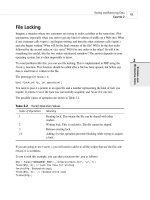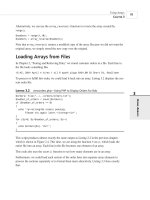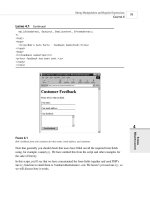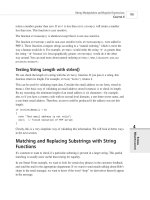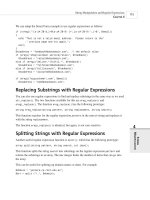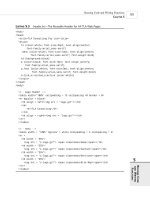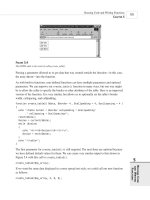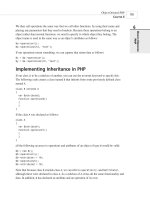Phát triển web với PHP và MySQL - p 12 pps
Bạn đang xem bản rút gọn của tài liệu. Xem và tải ngay bản đầy đủ của tài liệu tại đây (566.16 KB, 10 trang )
Alternatively, we can use the array_reverse() function to reverse the array created by
range().
$numbers = range(1,10);
$numbers = array_reverse($numbers);
Note that array_reverse() returns a modified copy of the array. Because we did not want the
original array, we simply stored the new copy over the original.
Loading Arrays from Files
In Chapter 2, “Storing and Retrieving Data,” we stored customer orders in a file. Each line in
the file looks something like
15:42, 20th April 4 tires 1 oil 6 spark plugs $434.00 22 Short St, Smalltown
To process or fulfill this order, we could load it back into an array. Listing 3.2 displays the cur-
rent order file.
LISTING 3.2 vieworders.php—Using PHP to Display Orders for Bob
$orders= file(“ / /orders/orders.txt”);
$number_of_orders = count($orders);
if ($number_of_orders == 0)
{
echo “<p><strong>No orders pending.
Please try again later.</strong></p>”;
}
for ($i=0; $i<$number_of_orders; $i++)
{
echo $orders[$i].”<br>”;
}
This script produces almost exactly the same output as Listing 2.2 in the previous chapter,
which is shown in Figure 2.4. This time, we are using the function file(), which loads the
entire file into an array. Each line in the file becomes one element of an array.
This code also uses the count() function to see how many elements are in an array.
Furthermore, we could load each section of the order lines into separate array elements to
process the sections separately or to format them more attractively. Listing 3.3 does exactly
that.
Using Arrays
C
HAPTER 3
3
USING ARRAYS
85
05 7842 CH03 3/6/01 3:42 PM Page 85
LISTING 3.3 vieworders2.php—Using PHP to Separate, Format, and Display Orders for Bob
<html>
<head>
<title>Bob’s Auto Parts – Customer Orders</title>
</head>
<body>
<h1>Bob’s Auto Parts</h1>
<h2>Customer Orders</h2>
<?
//Read in the entire file.
//Each order becomes an element in the array
$orders= file(“ / /orders/orders.txt”);
// count the number of orders in the array
$number_of_orders = count($orders);
if ($number_of_orders == 0)
{
echo “<p><strong>No orders pending.
Please try again later.</strong></p>”;
}
echo “<table border=1>\n”;
echo “<tr><th bgcolor = \”#CCCCFF\”>Order Date</td>
<th bgcolor = \”#CCCCFF\”>Tires</td>
<th bgcolor = \”#CCCCFF\”>Oil</td>
<th bgcolor = \”#CCCCFF\”>Spark Plugs</td>
<th bgcolor = \”#CCCCFF\”>Total</td>
<th bgcolor = \”#CCCCFF\”>Address</td>
<tr>”;
for ($i=0; $i<$number_of_orders; $i++)
{
//split up each line
$line = explode( “\t”, $orders[$i] );
// keep only the number of items ordered
$line[1] = intval( $line[1] );
$line[2] = intval( $line[2] );
$line[3] = intval( $line[3] );
// output each order
echo “<tr><td>$line[0]</td>
<td align = right>$line[1]</td>
<td align = right>$line[2]</td>
<td align = right>$line[3]</td>
<td align = right>$line[4]</td>
<td>$line[5]</td>
</tr>”;
}
echo “</table>”;
?>
</body>
</html>
Using PHP
P
ART I
86
05 7842 CH03 3/6/01 3:42 PM Page 86
The code in Listing 3.3 loads the entire file into an array but unlike the example in Listing 3.2,
here we are using the function explode() to split up each line, so that we can apply some pro-
cessing and formatting before printing.
The output from this script is shown in Figure 3.6.
Using Arrays
C
HAPTER 3
3
USING ARRAYS
87
FIGURE 3.6
After splitting order records with explode, we can put each part of an order in a different table cell for better looking
output.
The explode function has the following prototype:
array explode(string separator, string string)
In the previous chapter, we used the tab character as a delimiter when storing this data, so here
we called
explode( “\t”, $orders[$i] )
This “explodes” the passed-in string into parts. Each tab character becomes a break between
two elements. For example, the string
“15:42, 20th April\t4 tires\t1 oil\t
➥6 spark plugs\t$434.00\t22 Short St, Smalltown”
is exploded into the parts “15:42, 20th April”, “4 tires”, “1 oil”, “6 spark plugs”,
“$434.00”, and “22 Short St, Smalltown”.
We have not done very much processing here. Rather than output tires, oil, and spark plugs on
every line, we are only displaying the number of each and giving the table a heading row to
show what the numbers represent.
05 7842 CH03 3/6/01 3:42 PM Page 87
There are a number of ways that we could have extracted numbers from these strings. Here we
used the function, intval(). As mentioned in Chapter 1, intval() converts a string to an
integer. The conversion is reasonably clever and will ignore parts, such as the label in this
example, that cannot be converted to an integer. We will cover various ways of processing
strings in the next chapter.
Other Array Manipulations
So far, we have only covered about half the array processing functions. Many others will be
useful from time to time.
Navigating Within an Array: each, current(), reset(), end(),
next(), pos(), and prev()
We mentioned previously that every array has an internal pointer that points to the current ele-
ment in the array. We indirectly used this pointer earlier when using the each() function, but
we can directly use and manipulate this pointer.
If we create a new array, the current pointer is initialized to point to the first element in the
array. Calling current( $array_name ) returns the first element.
Calling either next() or each() advances the pointer forward one element. Calling
each( $array_name ) returns the current element before advancing the pointer. The function
next() behaves slightly differently—calling next( $array_name ) advances the pointer and
then returns the new current element.
We have already seen that reset() returns the pointer to the first element in the array.
Similarly, calling end( $array_name ) sends the pointer to the end of the array. The first and
last element in the array are returned by reset() and end(), respectively.
To move through an array in reverse order, we could use end() and prev(). The prev() func-
tion is the opposite of
next(). It moves the current pointer back one and then returns the new
current element.
For example, the following code displays an array in reverse order:
$value = end ($array);
while ($value)
{
echo “$value<br>”;
$value = prev($array);
}
If $array was declared like this:
$array = array(1, 2, 3);
Using PHP
P
ART I
88
05 7842 CH03 3/6/01 3:42 PM Page 88
the output would appear in a browser as
3
2
1
Using each(), current(), reset(), end(), next(), pos(), and prev(), you can write your
own code to navigate through an array in any order.
Applying Any Function to Each Element in an Array:
array_walk()
Sometimes you might want to work with or modify every element in an array in the same way.
The function array_walk() allows you to do this.
The prototype of
array_walk() is as follows:
int array_walk(array arr, string func, [mixed userdata])
Similar to the way we called usort() earlier, array_walk() expects you to declare a function
of your own.
As you can see, array_walk() takes three parameters. The first, arr, is the array to be
processed. The second, func, is the name of a user-defined function that will be applied to
each element in the array. The third parameter, userdata, is optional. If you use it, it will be
passed through to your function as a parameter. You’ll see how this works in a minute.
A handy user-defined function might be one that displays each element with some specified
formatting.
The following code displays each element on a new line by calling the user-defined function
myPrint() with each element of $array:
function myPrint($value)
{
echo “$value<BR>”;
}
array_walk($array, myPrint);
The function you write needs to have a particular signature. For each element in the array,
array_walk takes the key and value stored in the array, and anything you passed as userdata,
and calls your function like this:
Yourfunction(value, key, userdata)
For most uses, your function will only be using the values in the array. For some, you
might also need to pass a parameter to your function using the parameter userdata.
Using Arrays
C
HAPTER 3
3
USING ARRAYS
89
05 7842 CH03 3/6/01 3:42 PM Page 89
Occasionally, you might be interested in the key of each element as well as the value. Your
function can, as with MyPrint(), choose to ignore the key and userdata parameter.
For a slightly more complicated example, we will write a function that modifies the values in
the array and requires a parameter. Note that although we are not interested in the key, we need
to accept it in order to accept the third parameter.
function myMultiply(&$value, $key, $factor)
{
$value *= $factor;
}
array_walk(&$array, “myMultiply”, 3);
Here we are defining a function, myMultiply(), that will multiply each element in the array by
a supplied factor. We need to use the optional third parameter to
array_walk() to take a para-
meter to pass to our function and use it as the factor to multiply by. Because we need this para-
meter, we must define our function,
myMultiply(), to take three parameters—an array
element’s value ($value), an array element’s key ($key), and our parameter ($factor). We are
choosing to ignore the key.
A subtle point to note is the way we pass $value. The ampersand (&) before the variable name
in the definition of myMultiply() means that $value will be passed by reference. Passing by
reference allows the function to alter the contents of the array.
We will address passing by reference in more detail in Chapter 5. If you are not familiar with
the term, for now just note that to pass by reference, we place an ampersand before the variable
name.
Counting Elements in an Array: count(), sizeof(), and
array_count_values()
We used the function count() in an earlier example to count the number of elements in an
array of orders. The function
sizeof() has exactly the same purpose. Both these functions
return the number of elements in an array passed to them. You will get a count of one for the
number of elements in a normal scalar variable and 0 if you pass either an empty array or a
variable that has not been set.
The
array_count_values() function is more complex. If you call
array_count_values($array), this function counts how many times each unique value occurs
in the array $array. (This is the set cardinality of the array.) The function returns an associa-
tive array containing a frequency table. This array contains all the unique values from $array
as keys. Each key has a numeric value that tells you how many times the corresponding key
occurs in $array.
Using PHP
P
ART I
90
05 7842 CH03 3/6/01 3:42 PM Page 90
For example, the following code
$array = array(4, 5, 1, 2, 3, 1, 2, 1);
$ac = array_count_values($array);
creates an array called $ac that contains
Key Value
41
51
13
22
31
This indicates that 4, 5, and 3 occurred once in $array, 1 occurred three times, and 2 occurred
twice.
Converting Arrays to Scalar Variables: extract()
If we have an associative array with a number of key value pairs, we can turn them into a set
of scalar variables using the function extract(). The prototype for extract() is as follows:
extract(array var_array [, int extract_type] [, string prefix] );
The purpose of extract() is to take an array and create scalar variables with the names of the
keys in the array. The values of these variables are set to the values in the array.
Here is a simple example.
$array = array( “key1” => “value1”, “key2” => “value2”, “key3” => “value3”);
extract($array);
echo “$key1 $key2 $key3”;
This code produces the following output:
value1 value2 value3
The array had three elements with keys: key1, key2, and key3. Using extract(), we created
three scalar variables, $key1, $key2, and $key3. You can see from the output that the values of
$key1, $key2, and $key3 are “value1”, “value2”, and “value3”, respectively. These values
came from the original array.
There are two optional parameters to extract(): extract_type and prefix. The variable
extract_type tells extract() how to handle collisions. These are cases in which a variable
already exists with the same name as a key. The default response is to overwrite the existing
variable. Four allowable values for extract_type are shown in Table 3.1.
Using Arrays
C
HAPTER 3
3
USING ARRAYS
91
05 7842 CH03 3/6/01 3:42 PM Page 91
TABLE 3.1 Allowed extract_types for extract()
Type Meaning
EXTR_OVERWRITE Overwrites the existing variable when a collision occurs.
EXTR_SKIP Skips an element when a collision occurs.
EXTR_PREFIX_SAME Creates a variable named $prefix_key when a collision
occurs. You must supply prefix.
EXTR_PREFIX_ALL Prefixes all variable names with prefix. You must supply
prefix.
The two most useful options are the default (
EXTR_OVERWRITE) and EXTR_PREFIX_ALL. The
other two options might be useful occasionally when you know that a particular collision will
occur and want that key skipped or prefixed. A simple example using EXTR_PREFIX_ALL fol-
lows. You can see that the variables created are called prefix-underscore-keyname.
$array = array( “key1” => “value1”, “key2” => “value2”, “key3” => “value3”);
extract($array, EXTR_PREFIX_ALL, “myPrefix”);
echo “$myPrefix_key1 $myPrefix_key2 $myPrefix_key3”;
This code will again produce the output: value1 value2 value3.
Note that for extract() to extract an element, that element’s key must be a valid variable
name, which means that keys starting with numbers or including spaces will be skipped.
Further Reading
This chapter covers what we believe to be the most useful of PHP’s array functions. We have
chosen not to cover all the possible array functions. The online PHP manual available at
has a brief description of each of them.
Next
In the next chapter, we look at string processing functions. We will cover functions that search,
replace, split, and merge strings, as well as the powerful regular expression functions that can
perform almost any action on a string.
Using PHP
P
ART I
92
05 7842 CH03 3/6/01 3:42 PM Page 92
CHAPTER
4
String Manipulation and
Regular Expressions
06 7842 CH04 3/6/01 3:41 PM Page 93
Using PHP
P
ART I
94
In this chapter, we’ll discuss how you can use PHP’s string functions to format and manipulate
text. We’ll also discuss using string functions or regular expression functions to search (and
replace) words, phrases, or other patterns within a string.
These functions are useful in many contexts. You’ll often want to clean up or reformat user
input that is going to be stored in a database. Search functions are great when building search
engine applications (among other things).
In this chapter, we will cover
• Formatting strings
• Joining and splitting strings
• Comparing strings
• Matching and replacing substrings with string functions
• Using regular expressions
Example Application: Smart Form Mail
In this chapter, we’ll look at string and regular expression functions in the context of a Smart
Form Mail application. We’ll add these scripts to the Bob’s Auto Parts site we’ve been looking
at in the last few chapters.
This time, we’ll build a straightforward and commonly used customer feedback form for Bob’s
customers to enter their complaints and compliments, as shown in Figure 4.1. However, our
application will have one improvement over many you will find on the Web. Instead of email-
ing the form to a generic email address like ,we’ll attempt to put
some intelligence into the process by searching the input for key words and phrases and then
sending the email to the appropriate employee at Bob’s company. For example, if the email
contains the word “advertising,” we might send the feedback to the Marketing department. If
the email is from Bob’s biggest client, it can go straight to Bob.
We’ll start with the simple script shown in Listing 4.1 and add to it as we go along.
LISTING 4.1 processfeedback.php—Basic Script to Email Form Contents
<?
$toaddress = “”;
$subject = “Feedback from web site”;
$mailcontent = “Customer name: “.$name.”\n”
.”Customer email: “.$email.”\n”
.”Customer comments: \n”.$feedback.”\n”;
$fromaddress = “”;
06 7842 CH04 3/6/01 3:41 PM Page 94
